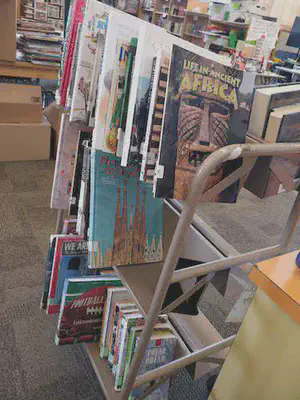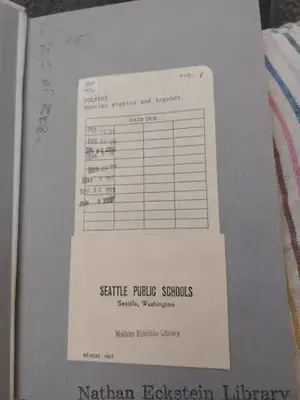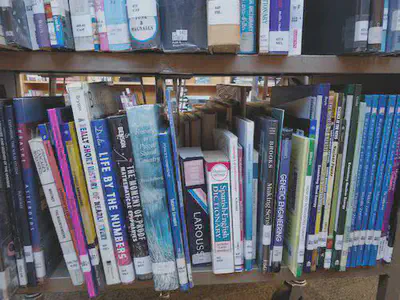Weekly Reflection 2
This week (April 8th) was primarily spent re-shelving checked-in materials and removing weeded books from the library catalog. While I don’t normally spend time re-shelving anything but non-fiction materials (since the library TAs mostly handle that), there was some backlog and I decided it was worth the time to be more familiar with the library layout and where books were shelved.

Other than that, my time was primarily spent in the non-fiction section. While books had/have been marked for weeding, they have not yet been deleted from the system. Instead, they are currently stacked on the shelves with post-its indicating that they are marked for weeding.

So, after shelving all of the pending non-fiction books and tidying up the narrative non-fiction section (since one of the grades had come through the day before looking for non-fiction books, and had done quite the number on it), I sat down with a laptop, a scanner, and the instructions for removing books from the system.

It was rather interesting looking at some of the books that had been marked for removal as I scanned them and scribbled out the barcodes before placing them in a cardboard box for easier disposal. Some of the books were falling apart, but some of them were in really good condition. Others were very clearly just outdated, while others were probably just not circulating well, and probably hadn’t been in some time.

While it was not a difficult task, it was fairly time-consuming, especially as I was also listening to the students that came into the library for their class that day. Each class was exactly the same, with the students filling out a survey, then playing a taboo/charades type game of guessing book titles from descriptions of the plot or of the title itself, and then had a ten minute or so long book rotation where they were previewing books and filling out another survey for their main teacher for the class (not Erin) so that in-class book clubs could be created, but still allowed the students some say in what they found interesting for said book clubs. There was also the books-and-bites group during first lunch, who were reading a comic book through Hoopla on the main screen while eating lunch. I took my own lunch time during this period, so I missed most of it, but it looked like something that I certainly would have enjoyed as a middle schooler (and still definitely would, so I may try to eat my lunch with them next time I am there at the same time as the group).
Ultimately, I got basically three boxes worth of books dealt with, though I did not have the opportunity to grab the third box and load it up due to classes trapping me in the non-fiction section due to how they were arranged in the library.

This was maybe a tenth of the books that are due to be removed, so I am sure that next time I am in the library (two weeks from now, due to spring break) I will continue with this particular task and see if I can get the rest removed from the collection so that other books can be added. Erin also set me up with a wishlist on the book buying service the school uses so that I can research and make notes of books that would fill a gap in the freshly-weeded nonfiction section, or even if I just know of a fiction title that would be a good addition to the collection that the library does not already own.

I did find it amusing that by the end of the day, I had basically memorized the Dewey numbers for non-fiction about African history and one of the ones for infectious diseases/health information (the 960s and 614.4, respectively). This quickly sped up several areas of shelving, since I remembered exactly where that number was on the shelves, especially the African history. My guess is that a class recently had a project on the topic, considering that it felt like I re-shelved half the available books on the subject.

There was also a smaller task that needed to be done, but only took a few minutes overall. Some of the non-fiction has been categorized by a previous DFW student, such as “LGBTQ History” and “Civil Rights – International,” and so I added those books to specific booklists so that sublocations can be added to the catalog for students looking for nonfiction on particular topics. I do not know if I will be continuing this categorization and adding further books to the list, but it would be interesting to have the whole non-fiction section eventually searchable by topic through sublocations.
(Also, I managed to empty out the whole re-shelving cart, even after refilling it a couple times!)
